Club Foot in Horses
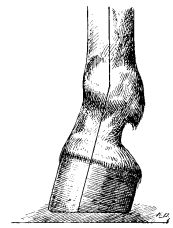
Identifying a Club Foot in Your Horse
"...Club foot hoof conformation is caused by a flexural deformity of the distal interphalangeal joint (DIP joint, also known as the coffin joint). Many people blame club feet on 'contracted tendons,' but this is a misnomer because tendons lack the ability to contract. Rather, a club foot results from shortening of the musculotendinous unit, causing hyperflexion of the DIP joint—more correctly called a flexural deformity. ..." How to Manage the Club Foot: Birth to Maturity 
There are several different degrees of club feet in horses (1 to 4; 4 being the most severe). Many can be helped with corrective shoeing. Some cannot be helped. Others may need an operation. Club feet can be in the forelimbs as well as in the hindlimbs. I have been told that club feet that are genetic usually come in pairs. Both front or both hind. If not genetic, "...an acquired flexural deformity develops anytime from 2 to 6 months of age due to a number of possible causes, such as nutritional imbalances, rapid growth, overexertion, and genetic predisposition. Generally, these involve the coffin joint. When managing these foals, restrict exercise to decrease trauma to the structures and administer non-steroidal anti-inflammatory drugs (NSAIDs) judiciously along with anti-ulcer medications since such drugs are notorious for inciting gastric ulcers in foals. Your veterinarian might administer oxytetracycline as well. The farrier can also apply an acrylic composite material to the horse's toe area to protect the front of the hoof; these are called toe caps. ..." How to Manage the Club Foot: Birth to Maturity  Other causes of club feet are: A disease that causes swelling and pain in the joints known as OCD (osteochondrosis-developmental disease) and Developmental Orthopedic Disease (DOD) in Horses, Osteochondrosis (OC), Osteochondritis Dessicans (OCD), Subchondral Bone Cysts (SBC), diet, ephiphysitis (a problem that occurs at the growth plates of young horses). If not genetic, club feet do not necessarily come in pairs. Other causes of club feet are: A disease that causes swelling and pain in the joints known as OCD (osteochondrosis-developmental disease) and Developmental Orthopedic Disease (DOD) in Horses, Osteochondrosis (OC), Osteochondritis Dessicans (OCD), Subchondral Bone Cysts (SBC), diet, ephiphysitis (a problem that occurs at the growth plates of young horses). If not genetic, club feet do not necessarily come in pairs.
- Club foot angles are often more than 60 degrees
- The heel will be higher than the normal foot
- Club foot hoof may looked dished
- The hoof may appear narrower than the normal hoof
- The frog will be smaller
- The horse's shoulder on the normal side will be more rounded than the shoulder on the normal side (foreleg with club)
- The shoulder on the club foot side will look more sloping and not as well muscled
- The same holds true for the hind end, but you will see the differences in the rear rather than the shoulder
- Horse will often lead with the normal foot
- Horse often stumbles with club foot
- While standing or grazing notice if horse has extend the normal foot
- While standing or grazing notice if horse's club foot will be back
Grades of Club Foot
- "Grade 1 - The hoof angle is three to five degrees greater than the opposing foot and a characteristic fullness is present at the coronary band due to partial luxation (partial dislocation) of P2 and P3 (the second phalanx bone and coffin bone).
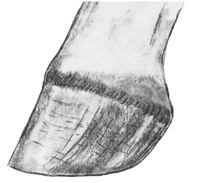
Club Foot Grade 1
- Grade 2--The hoof angle is five to eight degrees greater than the opposing foot with growth rings wider at the heel than at the toe. The heel will not touch the ground when trimmed to normal length. (Redden noted that Grade 1 and 2 club foot characteristics can appear very quickly, and that abscesses usually occur between grades 2 and 3.)
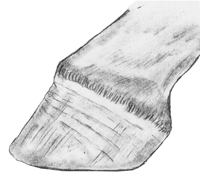
Club Foot Grade 2
- Grade 3--The anterior hoof wall is dished and growth rings at the heel are twice as wide as on the toe. Radiographically, P3 exhibits demineralization and lipping along the apex.
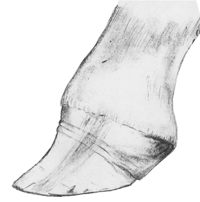
Club Foot Grade 3
- Grade 4--The anterior hoof wall is heavily dished and the angle is 80 degrees or more. The coronary band is as high at the heel as at the toe and the sole is below the ground surface of the wall. Radiographically, P3 is rounded due to extensive mineralization and rotation may be present.
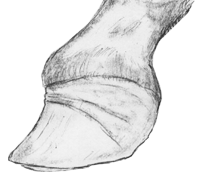
Club Foot Grade 4"
For an excellent article on Club Feet in Horses follow this link: Club Feet in Horses by: Les Sellnow
 This article is comprehensive and well written, easy to understand, and covers all four degress of club feet. This article is comprehensive and well written, easy to understand, and covers all four degress of club feet.
For shoeing a horse with club feet I would suggest following this link: Shoeing a Horse With Club Feet by Bubby Rhoderick, CMF  I know Bubby and he has worked on one of my past horses. He has a farrier school in Maryland. I know Bubby and he has worked on one of my past horses. He has a farrier school in Maryland.
For More Information:
Managing the Club Foot 
Club Foot  An excellent article/comprehensive/images An excellent article/comprehensive/images
Club Foot 
Inside the Club Foot 
|